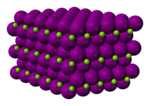Magnesium iodide
|
|
|||
|
|
|||
| Names | |||
|---|---|---|---|
|
IUPAC name
Magnesium iodide
|
|||
| Identifiers | |||
|
10377-58-9 (anhydrous) 75535-11-4 (hexahydrate) 7790-31-0 (octahydrate) |
|||
| 3D model (Jmol) | Interactive image | ||
| ChemSpider |
59700 |
||
| ECHA InfoCard | 100.030.738 | ||
| EC Number | 233-825-1 | ||
| PubChem | 66322 | ||
| UNII |
W74QE3H320 |
||
|
|||
|
|||
| Properties | |||
| MgI2 (anhydrous) MgI2.6H2O (hexahydrate) MgI2.8H2O (octahydrate) |
|||
| Molar mass | 278.1139 g/mol (anhydrous) 386.2005 g/mol (hexahydrate) 422.236 g/mol (octahydrate) |
||
| Appearance | white crystalline solid | ||
| Odor | odorless | ||
| Density | 4.43 g/cm3 (anhydrous solid) 2.353 g/cm3 (hexahydrate solid) 2.098 g/cm3 (octahydrate solid) |
||
| Melting point | 637 °C (1,179 °F; 910 K) (anhydrous, decomposes) 41 °C (octahydrate, decomposes) |
||
| 54.7 g/100 cm3 (anhydrous, 0 °C) 148 g/100 cm3 (anhydrous, 18 °C) 81 g/100 cm3 (octahydrate, 20 °C) |
|||
| Solubility | soluble in ether, alcohol and ammonia | ||
| −111.0·10−6 cm3/mol | |||
| Structure | |||
|
Hexagonal (anhydrous) Monoclinic (hexahydrate) Orthorhombic (octahydrate) |
|||
| Thermochemistry | |||
| 74 J/mol K | |||
|
Std molar
entropy (S |
134 J/mol K | ||
|
Std enthalpy of
formation (ΔfH |
-364 kJ/mol | ||
| Hazards | |||
| R-phrases | R36 R38 R42 R43 R61 | ||
| S-phrases | S22 S36/37/39 S45 S53 | ||
| NFPA 704 | |||
| Related compounds | |||
|
Other anions
|
Magnesium fluoride Magnesium bromide Magnesium chloride |
||
|
Other cations
|
beryllium iodide calcium iodide strontium iodide barium iodide |
||
|
Except where otherwise noted, data are given for materials in their standard state (at 25 °C [77 °F], 100 kPa).
|
|||
|
|
|||
| Infobox references | |||
Magnesium iodide is the name for the chemical compounds with the formulas MgI2 and its various hydrates MgI2(H2O)x. These salts are typical ionic halides, being highly soluble in water.
Magnesium iodide has few commercial uses but can be used to prepare compounds for organic synthesis.
Magnesium iodide can be prepared from magnesium oxide, magnesium hydroxide, and magnesium carbonate by treatment with hydroiodic acid:
Magnesium iodide is stable at high heat under a hydrogen atmosphere, but decomposes in air at normal temperatures, turning brown from the release of elemental iodine. When heated in air, it decomposes completely to magnesium oxide.
Another method to prepare MgI2 is mixing powdered elemental iodine and magnesium metal. In order to obtain anhydrous MgI2 the reaction should be conduct in a strictly anhydrous atmosphere and dry-diethyl ether can be used as a solvent.
Usage of magnesium iodide in the Baylis-Hillman reaction tends to give (Z)-vinyl compounds.
...
Wikipedia





